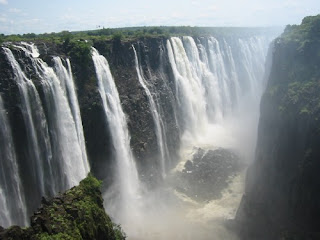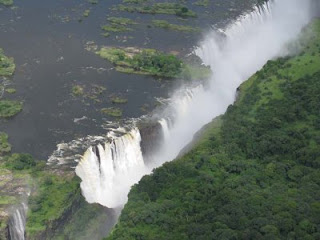The Victoria Falls constitutes one of the most spectacular Natural Wonders of the World. It is most commonly referred to as "Mosi-ao-Tunya" which means The Smoke that Thunders.
The Victoria Falls is located in the southern part of Africa on the Zambezi river between the countries of Zambia and Zimbabwe. It is attributed to as the world's largest sheet of falling water and it is one of the Seven Natural Wonders of the World. In the year 1855, David Livingstone, the Scottish missionary and explorer, is believed to have been the first European recorded to view the Victoria Falls. This waterfall is 1708 meters (5604 ft) in width and 108 meters (354 ft) in height, which is roughly twice the height of North America's Niagara Falls and over twice the width of its Horseshoe Falls. The falls are formed as the full width of the river plummets in a single vertical drop into a transverse chasm, carved by its waters along a fracture zone in the basalt plateau. The dept of the chasm varies from 80 meters (262.5 ft) at its western end to 108 meters (354.3 ft) in the center, and this is called the First Gorge. The only outlet to the First Gorge is a 110 meters (360.9 ft) wide gap about two-thirds of the way across the width of the falls from the western end, through which the whole volume of the river pours into the Victoria Falls gorges.
The falls are actually split into a number of separate waterfalls owing to the small islands dotted along the top of the Falls that interrupt the curtain of water. Boaruka Island near the western bank and Livingstone Island near the middle are the two important islands on the crest of the falls that are large enough to separate the curtain of water even at the full flood. The other islands that divide the curtain of water into separate parallel streams are: Devil's Cataract, Main Falls, Rainbow Falls and the Eastern Cataract.
The river's annual flood season is from Feb to May with a peak in April. During this full flood season, the spray from the falls typically rises to a height of over 400 meters and sometimes even twice as height and is visible from upto 50 km away. So, during this time of the year, the falls cannot be seen on foot on the Zimbabwe side with clouds of spray rising height into the sky and drenching all tourists. But it is the best time to see "Moonbow" that forms in the spray, at the full moon, instead of the normal daylight rainbow. From May as the annual flood abates, the view of the falls gets better and most of the Victoria Falls can be seen.

